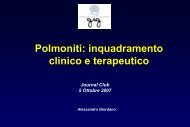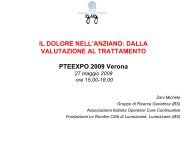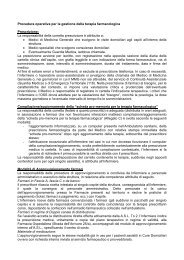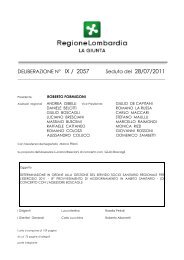Diapositive in formato pdf - GrG
Diapositive in formato pdf - GrG
Diapositive in formato pdf - GrG
You also want an ePaper? Increase the reach of your titles
YUMPU automatically turns print PDFs into web optimized ePapers that Google loves.
Le s<strong>in</strong>dromi<br />
paraneoplastiche<br />
Luca ROZZINI<br />
Cl<strong>in</strong>ica Neurologica Università degli Studi di Brescia<br />
Gruppo di Ricerca Geriatrica
CASO CLINICO<br />
Uomo di 67 anni, con disturbo cognitivo nas da circa<br />
dieci giorni.
Anamnesi fisiologica e sociale<br />
VB, maschio, anni 67.<br />
Coniugato, vive con la moglie.<br />
Laureato <strong>in</strong> economia e commercio svolge la professione imprenditore,<br />
commerciante.<br />
Destrimane.<br />
Dieta regolare, digestione regolare; alvo regolare; peso stabile.<br />
Assume alcoolici occasionalmente.<br />
Fuma 20 sigarette al giorno.<br />
Diuresi nella norma.<br />
Non riferite allergie o <strong>in</strong>tolleranze.
Anamnesi familiare<br />
Madre deceduta 82 aa, per causa non nota,affetta da<br />
diabete mellito.<br />
Padre deceduto a 90 aa, causa non nota.<br />
Di otto germani, quattro sono deceduti (tumore<br />
cerebrale, tumore ai testicoli, tumore ovarico ed<br />
<strong>in</strong>cidente stradale, rispettivamente).
Anamnesi patologica remota<br />
Ipercolesterolemia ben controllata da terapia<br />
farmacologica.<br />
Diabete mellito II tipo da circa tre mesi.
Motivo del ricovero<br />
P.S il 10 luglio 2006. Da una settimana riferiti episodi di<br />
debolezza agli arti <strong>in</strong>feriori con caduta a terra, senza<br />
perdita di coscienza. Difficoltà nell’articolazione delle<br />
parole, rottura del contatto, deposto stato confusionale,<br />
facile irritabilità.<br />
Per tale ragione ha eseguito ambulatorialmente (5 luglio)<br />
TC encefalo senza mdc ed ECO TSA: nella norma.<br />
Si ricovera <strong>in</strong> Neurologia nel sospetto di crisi parziali<br />
complesse.
Ricovero Cl<strong>in</strong>ica Neurologica<br />
ESAME OBBIETTIVO NEUROLOGICO<br />
Stato Mentale: vigile, rallentamento ideomotorio, sensorio <strong>in</strong>denne, collaborante,<br />
orientato nel tempo e nello spazio;<br />
Nervi Cranici: <strong>in</strong>denni; MOE nella norma; pupille isocoriche, isocicliche,<br />
normoreagenti allo stimolo lum<strong>in</strong>oso ed alla accomodazione consensuale;<br />
normoacusia;non morsus l<strong>in</strong>guae.<br />
Motilità e Tono Muscolare:M<strong>in</strong>gazz<strong>in</strong>i I mantenuto per 60 sec. con pronazione AS<br />
s<strong>in</strong>istro; prove di forza segmentarie nella norma; Arti <strong>in</strong>feriori: a s<strong>in</strong>istra mantiene<br />
M<strong>in</strong>gazz<strong>in</strong>i per 60 sec. con slivellamento bloccato di circa 5 cm.<br />
Sensibilità: nella norma la sensibilità superficiale e profonda su tutto l’ambito corporeo.<br />
Andatura e Postura: autonoma, a base ristretta, Romberg -.<br />
Funz. Cerebellare: prova Indice-Naso e Tallone-G<strong>in</strong>occhio diss<strong>in</strong>ergiche a sisnistra<br />
come da aprassia.<br />
Riflessi Osteo-Tend<strong>in</strong>ei: riflessi normali e asimmetrici ai 4 arti per s<strong>in</strong>>dx; Bab<strong>in</strong>ski e<br />
Hoffman assenti; riflessi addom<strong>in</strong>ali validi.<br />
Riflessi Primitivi: glabellare, muso e riflesso di prensione assenti, palmo-mentoniero<br />
assente.
Ricovero Cl<strong>in</strong>ica Neurologica<br />
Vengono richiesti:<br />
EEG nel sospetto di crisi comiziale.<br />
RM encefalo nel sospetto di processo<br />
espansivo (prima ipotesi).<br />
RX torace <strong>in</strong> forte fumatore.<br />
Esami ematochimici di rout<strong>in</strong>e.
<strong>in</strong>gresso <strong>in</strong>gresso<br />
Emocromo<br />
G.bianchi 4-10.8mila/mm 3 4.92 Prote<strong>in</strong>e totali 6-8 g/dl 6.3<br />
G.rossi 4.5-5.5; 10 6 i/mm 3 4.29** Album<strong>in</strong>a 55-69%; 63.4<br />
Hb 14-18; g/dl 15.2 alfa1 2-4% 2.3<br />
Hct 42-52 ; % 43.0 alfa2 6-11% 8.2<br />
MCV 82-99 fl 100.1** beta 7-14% 9.3<br />
Piastr<strong>in</strong>e 130-400 mila/mm 3 139 gamma 12-19% 16.8<br />
Formula leucocitaria Es.ur<strong>in</strong>e<br />
Neutrofili 40-74% 64.5 peso specifico 1.002-1.030 1.022<br />
L<strong>in</strong>fociti 20-45% 25.4 pH
11.07.06<br />
Valutazione NPS cl<strong>in</strong>ica al letto: non deficit di<br />
l<strong>in</strong>guaggio (produzione verbale, comprensione<br />
ripetizione).<br />
Appare rallentato sul piano ideativo, fatuo. MMSE<br />
29/30<br />
EEG: anomalie elettriche prevalentemente di tipo<br />
lento fronto-centrali bilaterali con lieve prevalenza a<br />
s<strong>in</strong>istra.
12.07.06<br />
RX torace: nel segmento apicale del lobo superiore<br />
dx si riconosce opacità nodulare di circa 2 cm. Utile<br />
TC. Cuore nei limiti. Aorta con calcificazioni parietali.
15.07.06<br />
TAC torace: nel segmento apicale del lobo superiore dx, nodulo del<br />
diametro di 2 cm con profili regolari collegato alla pleura parietocostale<br />
da sottili tralci parenchimali, adeso al nodulo di maggiori<br />
dimensioni è riconoscibile altra opacità a morfologia ovalare del<br />
diametro di circa 1 cm. I rilievi descritti sono compatibili con lesione<br />
parenchimale contigua a bronchiectasia ripiena e necessitano<br />
pertanto di valutazione con broncoscopia ed eventuale<br />
approfondimento diagnostico con biopsia transtoracica. Nodulo del<br />
diametro di 3 mm nel segmento apicale del lobo <strong>in</strong>feriore dx <strong>in</strong> sede<br />
subpleurica. Non versamento pleurico o pericardico. Non significative<br />
l<strong>in</strong>foadenopatie agli ili e nel mediast<strong>in</strong>o.
15.07.06<br />
RM encefalo: non aree di alterato segnale, ad eccezione di<br />
focale area di gliosi iper<strong>in</strong>tensa nelle sequenze T2<br />
dipendenti nelle sostanza bianca adiacante il corno<br />
occipitale del ventricolo laterale dx, probabile esito<br />
ischemico. Sistema ventricolare nella norma. Non aree di<br />
patologica impregnazione dopo somm<strong>in</strong>istrazione di<br />
Gadol<strong>in</strong>io. Strutture mediane <strong>in</strong> asse.
Consulenza chirurgia toracica (15.07.06 e<br />
rivalutazione17.07.06): sospetta Npl polmonare,<br />
<strong>in</strong>dicato completamento della stadiazione da<br />
eseguire <strong>in</strong> DH.
Dimissione 17.7.06<br />
• Opacità polmonare <strong>in</strong> fase di def<strong>in</strong>izione<br />
• Deposto stato confusionale (accertamenti cl<strong>in</strong>ic<strong>in</strong>euroradiologici<br />
negativi)<br />
• Encefalopatia lacunare<br />
• Diabete mellito tipo 2<br />
• Ipercolesterolemia
Terapia<br />
Eskim 1000 mg 1 cp ore 20<br />
Torvast 20 mg 1 cp ore 20<br />
Cardioaspir<strong>in</strong> 1 cp ore 13
Ricovero Cl<strong>in</strong>ica Neurologia 19.07.06<br />
Motivo del ricovero. Il paziente, già noto al reparto per<br />
recente ricovero per stato confusionale acuto (dimesso <strong>in</strong><br />
data 17.07.2006 dopo esecuzione di accertamenti cl<strong>in</strong>ic<strong>in</strong>euroradiologici<br />
risultati negativi), è giunto alla nostra<br />
osservazione per nuovo episodio confusionale acuto<br />
caratterizzato da disorientamento spazio-temporale,<br />
amnesia per eventi recenti e volti noti. La moglie segnalava,<br />
<strong>in</strong>oltre, alterazioni della personalità <strong>in</strong>sorte nell'ultimo mese.
Stato Mentale<br />
Nervi Cranici<br />
Motilità e Tono<br />
Muscolare<br />
Sensibilità<br />
Andatura e Postura<br />
Funz. Cerebellare<br />
Riflessi Osteo-Tend<strong>in</strong>ei<br />
Riflessi Primitivi<br />
Pz. vigile, psiche lucida, sensorio <strong>in</strong>denne, collaborante, disorientato nel tempo<br />
e nello spazio; deficit di memoria episodica e nel riconoscimento di volti noti,<br />
deficit attentivo e nelle funzioni esecutive.<br />
Dubbio deficit faciale sn; MOE nella norma; Pupille isocoriche, normoreagenti<br />
allo stimolo lum<strong>in</strong>oso; normoacusia;<br />
Prove di forza segmentarie nella norma; motilità f<strong>in</strong>e conservata; sequenze<br />
motorie e movimenti alternati <strong>in</strong>denni; tono muscolare nella norma<br />
Nella norma la sensibilità superficiale e profonda su tutto l’ambito corporeo<br />
Deambulazione, possibile senza aiuto, a base allargata; prova del “funambolo"<br />
non correttamente eseguita; equilibrio conservato nei cambiamenti di direzione;<br />
postura <strong>in</strong>differente; Romberg negativo;<br />
Frenage alla prova Indice-Naso ; Prova del rimbalzo positiva; Prova degli Indici<br />
Indenne; Adiadococ<strong>in</strong>esia assente;<br />
Riflessi normali e simmetrici ai 4 arti; Bab<strong>in</strong>ski e Hoffman assenti; riflessi<br />
addom<strong>in</strong>ali validi;<br />
Glabellare, Muso e Palmo-Mentoniero assenti; riflesso di prensione assente<br />
S<strong>in</strong>tesi: Segni neurologici di focalità assenti; disorientamento spazio-temporale ed amnesia per eventi<br />
recenti e volti noti.<br />
MMSE 29/30
Ricovero Cl<strong>in</strong>ica Neurologia 19.07.06<br />
Nel sospetto di NPL cerebrale (l<strong>in</strong>foma malattia<br />
neurodegenerativa come da Malattia di Creutzfeldt-Jakob)<br />
esegue rachicentesi (19.07): negativa per entrambe le<br />
condizioni morbose ipotizzate.<br />
Consulenza specialistica, chirurgia toracica (19.07):<br />
rivalutata la TC torace senza m.d.c. Sono presenti segni<br />
radiologici sospetti per neoplasia, anche senza poter<br />
escludere lesione vascolare. Pertanto può essere opportuno<br />
richiedere nuova TC torace con m.d.c. per approfondire la<br />
lesione.
Ricovero Cl<strong>in</strong>ica Neurologia 19.07.06<br />
EcoCardiogramma transtoracico (20.07.06): Ventricolo s<strong>in</strong>istro non<br />
dilatato, normoc<strong>in</strong>etico, mitrale cont<strong>in</strong>ente. Ventricolo destro non<br />
dilatato, normocicnetico. Setto <strong>in</strong>teratriale apparentemente <strong>in</strong>tegro.<br />
Dopo <strong>in</strong>iezione di soluzione sal<strong>in</strong>a <strong>in</strong> vena periferica si evidenzia<br />
passaggio di 3-4 bolle <strong>in</strong> fase tardiva. Non si può escludere la<br />
presenza di MAV periferica. Utile esecuzione di EcoCardiogramma<br />
transesofageo.<br />
EcoCardiogramma transesofageo (21.07.06):<br />
Si conferma l'assenza di shunts <strong>in</strong>tracavitari e la presenza di bolle di<br />
ritrono tardivo da possibile MAV nel circolo polmonare. Niente di<br />
particolare per il resto nelle cavità cardiache. AORTA: lieve ectasia<br />
del tratto ascendente. Rigurgito lieve (+). Non trombosi nell'arco.<br />
Ateromasia non complicata nel tratto toracico.
Ricovero Cl<strong>in</strong>ica Neurologia 19.07.06<br />
EEG (21.07.06): immodificato rispetto al precedente<br />
controllo, caratterizzato da alterazioni elettriche<br />
centro-anteriori bilaterali, prevalenti a s<strong>in</strong>istra, ridotte<br />
dagli stimoli sensoriali.<br />
Sc<strong>in</strong>tigrafia scheletrica total body (21.07.06):<br />
L'<strong>in</strong>dag<strong>in</strong>e sc<strong>in</strong>tigrafica non ha evidenziato la<br />
presenza di aree di iperaccumulo del radiofarmaco<br />
riferibile alla presenza di secondarismi scheletrici.
Ricovero Cl<strong>in</strong>ica Neurologia 19.07.06<br />
Prove di funzionalità respiratoria (21.07.06): <strong>in</strong>dici<br />
funzionali respiratori nei limiti della norma. Discreto aumento<br />
del ristagno aereo. Diffusione alveolo-capillare del CO nei<br />
limiti della norma. EAB <strong>in</strong> aria: lieve ipossiemia con<br />
normocapnia. Dal punto di vista pneumofunzionale non<br />
contro<strong>in</strong>dicazioni ad <strong>in</strong>tervento di resezione polmonare.
Ricovero Cl<strong>in</strong>ica Neurologia 19.07.06<br />
TORACE<br />
L'esame viene confrontato con analogo precedente del 14/07/06. Al controllo attuale<br />
<strong>in</strong>variata la lesione nodulare nel segmento apicale del lobo superiore dx che non<br />
presenta le caratteristiche di malformazione artero-venosa. Invariati i restanti rilievi<br />
parenchimali. Alcuni l<strong>in</strong>fonodi all'ilo destro, il maggiore con diametro di 11 mm. alcuni<br />
l<strong>in</strong>fonodi anche <strong>in</strong> sede paratracheale, il maggiore di 9 mm, <strong>in</strong>variati i restanti rilievi.<br />
ADDOME<br />
Non lesioni di fegato, milza, pancreas, surreni e reni (cisti corticali a s<strong>in</strong>istra, la<br />
maggiore con diametro di 15 mm), Calcificazioni prostatiche. Non adenopatie <strong>in</strong>tra- o<br />
retroperitoneali. Non versamento libero <strong>in</strong> addome.<br />
ENCEFALO<br />
Non aree di impregnazione a significato patologico.
Ricovero Cl<strong>in</strong>ica Neurologia 19.07.06<br />
Decorso durante la degenza: durante il ricovero il paziente è apparso tranquillo, ha<br />
assunto la terapia <strong>in</strong> modo regolare. Persiste stato confusionale con amnesia per<br />
eventi recenti. Viene segnalato un episodio di perdita di contatto di durata non nota<br />
osservata dal tecnico EEG appena dopo esecuzione del tracciato. Tale episodio è<br />
apparso analogo a quelli verificatisi a domicilio ed <strong>in</strong>dagati nel precedente ricovero<br />
ed è, pertanto, riferibile ad epilessia s<strong>in</strong>tomatica che si esprime con crisi parziali<br />
complesse.<br />
Epicrisi: paziente già noto per recente ricovero <strong>in</strong> questo reparto, giunge<br />
all'osservazione per <strong>in</strong>sorgenza di nuovo episodio confusionale con disorientamento<br />
spazio-temporale ed amnesia per eventi recenti e volti noti. É stata eseguita<br />
rachicentesi <strong>in</strong> urgenza, che non ha evidenziato alterazioni patologiche. Sono<br />
proseguiti accertamenti già <strong>in</strong> corso nel precedente ricovero per lesione polmonare.<br />
Le <strong>in</strong>dag<strong>in</strong>i effettuate sembrerebbero attualmente escludere l'ipotesi di una<br />
malformazione artero-venosa polmonare ed avvalorare il sospetto di neoplasia<br />
polmonare. La s<strong>in</strong>tomatologia neurologica presentata dal paziente potrebbe essere<br />
compatibile con s<strong>in</strong>drome paraneoplastica (encefalite limbica) secondaria al<br />
processo espansivo polmonare.
Trasferito <strong>in</strong> Chirurgia Toracica 27.7.06<br />
•Stato confusionale acuto<br />
•Epilessia s<strong>in</strong>tomatica (crisi parziali complesse)<br />
•Opacità polmonare <strong>in</strong> fase di def<strong>in</strong>izione diagnostica<br />
•Encefalopatia lacunare<br />
•Diabete Mellito di II tipo<br />
•Ipercolesterolemia
The term paraneoplasticneurologicaldisorders<br />
(PND) was first co<strong>in</strong>ed for all non-metastatic<br />
neurological complications of cancer <strong>in</strong> which no<br />
specific aetiology—such as vascular, <strong>in</strong>fectious,<br />
metabolic, or treatment-related causes—could be<br />
def<strong>in</strong>ed.
Cl<strong>in</strong>icians can now make a def<strong>in</strong>ite diagnosis<br />
easily. However, the developments have also led<br />
to some confusion, because one antibody can be<br />
found <strong>in</strong> different neurological syndromes, and one<br />
syndrome can be associated with different<br />
antibodies.
Pathological features:<br />
• Any part of CNS can be affected<br />
• S<strong>in</strong>gle cell type e.g., Purk<strong>in</strong>je cells<br />
• S<strong>in</strong>gle area e.g., limbic encephalitis<br />
• Multiple level e.g., encephalomyeloradiculitis<br />
(<strong>in</strong>flammation of bra<strong>in</strong>, sp<strong>in</strong>al cord & sp<strong>in</strong>al roots)
Neurological symptoms:<br />
• Signs and symptoms are diverse<br />
• Rapid onset<br />
• Often precede the detection of the paraneoplastic<br />
tumours (>60%)<br />
• Results from an autoimmune response aga<strong>in</strong>st<br />
neuronal antigens
Nomenclature: is not <strong>in</strong>ternationally agreed<br />
• Two systems exist<br />
One based on first two letters of the surname of the patient<br />
Second based on morphological distribution of the antibody<br />
• To date, both systems are be<strong>in</strong>g used
S<strong>in</strong>ce the discovery of highly specific ant<strong>in</strong>euronal<br />
antibodies <strong>in</strong> the serum of patients with PND of the<br />
CNS, the autoimmune pathogenesis seems highly<br />
likely also for this group of patients.
A tumor not <strong>in</strong>volv<strong>in</strong>g the nervous system<br />
expresses a neuronal prote<strong>in</strong> that the<br />
immune system recognizes as nonself.<br />
Onconeural Ab<br />
Apoptotic tumor cells are phagocytized by<br />
dendritic cells that migrate to lymph<br />
nodes, where they activate antigenspecific<br />
CD4+, CD8+, and B cells.<br />
The B cells mature <strong>in</strong>to plasma cells that<br />
produce antibodies aga<strong>in</strong>st the tumor<br />
antigen.<br />
The antibodies or the cytotoxic CD8+ T<br />
cells (or both) slow the growth of the<br />
tumor, but they also react with portions of<br />
the nervous system outside the blood–<br />
bra<strong>in</strong> barrier.<br />
In the illustration, antibodies are react<strong>in</strong>g<br />
with voltage-gated calcium channels at the<br />
neuromuscular junction, caus<strong>in</strong>g the<br />
Lambert–Eaton myasthenic syndrome. In<br />
some <strong>in</strong>stances, plasma cells and<br />
cytotoxic T cells cross the blood–bra<strong>in</strong><br />
barrier and attack neurons express<strong>in</strong>g the<br />
antigen they share with the tumor.
Recommended diagnostic<br />
criteria for paraneoplastic<br />
neurological syndromes<br />
F Graus et al. J. Neurol. Neurosurg. Psychiatry, 2004; 75:<br />
1135 -1140.
… the panel concluded that the diagnostic criteria<br />
of a neurological syndrome as paraneoplastic<br />
should be based on the presence or absence of<br />
cancer and the def<strong>in</strong>itions of classical<br />
syndrome and well characterized onconeural<br />
antibodies.
Classical syndrome
Classical and non-classical paraneoplastic neurological<br />
syndromes<br />
Syndromes of the central nervous system<br />
Encephalomyelitis<br />
Limbic encephalitis<br />
Bra<strong>in</strong>stem encephalitis<br />
Subacute cerebellar degeneration<br />
Opsoclonus-myoclonus*<br />
Optic neuritis<br />
Cancer associated ret<strong>in</strong>opathy<br />
Melanoma associated ret<strong>in</strong>opathy<br />
Stiff person syndrome<br />
Necrotis<strong>in</strong>g myelopathy<br />
Motor neuron diseases
Classical and non-classical paraneoplastic neurological<br />
syndromes<br />
Syndromes of the peripheral nervous system<br />
Subacute sensory neuronopathy<br />
Acute sensorimotor neuropathy<br />
Guilla<strong>in</strong>-Barré syndrome<br />
Brachial neuritis<br />
Subacute/chronic sensorimotor neuropathies*<br />
Neuropathy and paraprote<strong>in</strong>aemia<br />
Neuropathy with vasculitis<br />
Autonomic neuropathies<br />
Chronic gastro<strong>in</strong>test<strong>in</strong>al pseudo-obstruction<br />
Acute pandysautonomia
Classical and non-classical paraneoplastic neurological<br />
syndromes<br />
Syndromes of the neuromuscular<br />
junction and muscle<br />
Myasthenia gravis<br />
Lambert-Eaton myasthenic syndrome<br />
Acquired neuromyotonia<br />
Dermatomyositis<br />
Acute necrotis<strong>in</strong>g myopathy
Encephalomyelitis<br />
To describe those patients with cancer who developed<br />
cl<strong>in</strong>ical or pathological dysfunction of various parts of<br />
the nervous system.<br />
It as been recommended use of the term<br />
encephalomyelitis to describe those patients with<br />
relevant cl<strong>in</strong>ical dysfunction at multiple levels of the<br />
central nervous system <strong>in</strong>clud<strong>in</strong>g the dorsal root ganglia<br />
or plexes.
Encephalomyelitis<br />
-In 75% of PEM patients the underly<strong>in</strong>g neoplasm is a small cell lung<br />
cancer.<br />
-Sensory neuronopathy is the most common cl<strong>in</strong>ical syndrome.<br />
-Other common manifestations of PEM are, bra<strong>in</strong>stem encephalitis,<br />
cerebellar symptoms, motor weakness, and autonomic dysfunction.<br />
-The symptoms of bra<strong>in</strong>stem encephalitis reflect the predom<strong>in</strong>ant<br />
<strong>in</strong>volvement of the floor of the fourth ventricle and the <strong>in</strong>ferior olives<br />
and <strong>in</strong>clude vertigo, nystagmus, oscillopsia, ataxia, diplopia, dysarthria,<br />
and dysphagia.<br />
-The autonomic nervous system is affected <strong>in</strong> 30% of the patients; few<br />
patients develop a chronic <strong>in</strong>test<strong>in</strong>al pseudoobstruction due to damage<br />
of the neurons of the myenteric plexus.
Ma<strong>in</strong> cl<strong>in</strong>ical syndromes observed <strong>in</strong> encephalomyelitis<br />
Syndrome<br />
Pathological <strong>in</strong>volvement<br />
Limbic encephalitis<br />
Bra<strong>in</strong>stem encephalitis (predom<strong>in</strong>antly bulbar)<br />
Hippocampus, amygdala<br />
Medulla oblongata<br />
Cerebellar degeneration<br />
Myelitis (anterior horn)<br />
Sensory neuronopathy<br />
Chronic gastro<strong>in</strong>test<strong>in</strong>al pseudo-obstruction<br />
Purk<strong>in</strong>je cells<br />
Motor neurons<br />
Dorsal root ganglia<br />
Myenteric plexus
Paraneoplastic limbic encephalitis<br />
-Patients may develop (acute or subacute) short-term memory loss or<br />
amnesia, become disoriented, or may show psychosis <strong>in</strong>clud<strong>in</strong>g<br />
visual or auditory halluc<strong>in</strong>ations, or paranoid obsession.<br />
-Confusion, depression and anxiety are also common.<br />
-Generalized or partial complex seizures are seen <strong>in</strong> about 50% of<br />
patients. In the majority of patients, the symptoms antedate the<br />
diagnosis of a tumor by a mean of 3– 5 months.<br />
-PLE is preferentially associated with small cell lung cancer (SCLC)<br />
(40%), germ cell tumors of the testis (20%), breast cancer (8%),<br />
Hodgk<strong>in</strong>’s lymphoma, thymoma and immature teratoma.
Investigation<br />
• Magnetic resonance imag<strong>in</strong>g (MRI) alterations <strong>in</strong> PLE are<br />
seen <strong>in</strong> about 60%;<br />
• In 45% of patients, EEG reveals epileptic abnormalities<br />
from the temporal lobe, but <strong>in</strong> the majority of patients it<br />
shows unilateral or bilateral temporal slow waves;<br />
• Cerebrosp<strong>in</strong>al fluid (CSF) exam<strong>in</strong>ations show <strong>in</strong>flammatory<br />
signs (e.g. pleocytosis and oligoclonal bands) <strong>in</strong> about 60%<br />
of patients;<br />
• Onconeuronal antibodies may be found <strong>in</strong> the serum and<br />
CSF of about 60% of patients with PLE.
Paraneoplastic cerebellar degeneration<br />
• Is characterized by subacute development of a<br />
severe pancerebellar dysfunction. Cerebellar signs<br />
usually beg<strong>in</strong> with gait ataxia and, over a few weeks<br />
or months, progress to severe, usually symmetrical<br />
truncal and limb ataxia, with dysarthria and often<br />
nystagmus.<br />
• Occasionally the onset is rapid, with<strong>in</strong> a few hours<br />
or days. Vertigo is common, and many patients<br />
compla<strong>in</strong> of diplopia.<br />
• PCD is preferentially associated with ovarian<br />
cancer, breast cancer, SCLC or Hodgk<strong>in</strong>’s disease.
Investigation<br />
• Bra<strong>in</strong> MRI studies are <strong>in</strong>itially normal, but can<br />
demonstrate cerebellar atrophy <strong>in</strong> the latter stages<br />
of the disease.<br />
• CSF exam<strong>in</strong>ation shows <strong>in</strong>flammatory signs without<br />
cancer cells (e.g. pleocytosis and oligoclonal bands)<br />
<strong>in</strong> about 60% of PCD patients.<br />
• Yo antibodies are most frequently associated with<br />
PCD.
Subacute sensory neuronopathy<br />
• Several neuropathies have been reported as paraneoplastic, but only<br />
SSN is regarded as a classical PNS.<br />
• SSN is associated with SCLC <strong>in</strong> 70–80% of cases, but may also occur<br />
with breast cancer, ovarian cancer, sarcoma or Hodgk<strong>in</strong>’s disease.<br />
• SSN precedes the overt cl<strong>in</strong>ical manifestations of the cancer with a<br />
median delay of 4.5 months.<br />
• Symptoms consist of pa<strong>in</strong> and paraesthesiae. Upper limbs are usually<br />
affected first or almost <strong>in</strong>variably <strong>in</strong>volved with the evolution. Sensory<br />
loss, especially affect<strong>in</strong>g deep sensation, often leads to severe<br />
sensory ataxia and tendon reflexes are absent. Autonomic neuropathy<br />
<strong>in</strong>clud<strong>in</strong>g digestive pseudo-obstruction is frequent.
… the panel concluded that the diagnostic criteria<br />
of a neurological syndrome as paraneoplastic<br />
should be based on the presence or absence of<br />
cancer and the def<strong>in</strong>itions of classical<br />
syndrome and well charcterised onconeural<br />
antibodies.
Paraneoplastic CNS auto-antibodies:<br />
Divided <strong>in</strong>to 3 groups based on immunocytochemical<br />
distribution of antibodies<br />
1. B<strong>in</strong>d<strong>in</strong>g to Purk<strong>in</strong>je cell cytoplasm<br />
2. B<strong>in</strong>d<strong>in</strong>g to neuronal nuclei<br />
3. Others
Some antibodies have been described by a s<strong>in</strong>gle<br />
group of <strong>in</strong>vestigators or reported <strong>in</strong> only a few patients.<br />
Although most onconeural antibodies described appear<br />
to be specific for PNS, a few patients never develop<br />
cancer after follow up of several years.<br />
In the absence of detected tumor, only well<br />
characterized onconeural antibodies (anti Hu, Yo, CV2,<br />
Ri, MA2, amphiphys<strong>in</strong>) should be used to classify the<br />
associated disorder as def<strong>in</strong>ite PNS.
Diagnostic criteria for paraneoplastic neurological syndromes (PNS)<br />
Def<strong>in</strong>ite PNS<br />
1. A classical syndrome and cancer that develops with<strong>in</strong> five years of the diagnosis of the neurological<br />
disorder.<br />
2. A non-classical syndrome that resolves or significantly improves after cancer treatment without<br />
concomitant immunotherapy, provided that the syndrome is not susceptible to spontaneous remission.<br />
3. A non-classical syndrome with onconeural antibodies (well characterised or not) and cancer that<br />
develops with<strong>in</strong> five years of the diagnosis of the neurological disorder.<br />
4. A neurological syndrome (classical or not) with well characterised onconeural antibodies (anti-Hu,<br />
Yo, CV2, Ri, Ma2, or amphiphys<strong>in</strong>), and no cancer.<br />
Possible PNS<br />
1. A classical syndrome, no onconeural antibodies, no cancer but at high risk to have an underly<strong>in</strong>g<br />
tumour.<br />
2. A neurological syndrome (classical or not) with partially characterised onconeural antibodies and no<br />
cancer.<br />
3. A non-classical syndrome, no onconeural antibodies, and cancer present with<strong>in</strong> two years of<br />
diagnosis.
Figure 1 Flow chart show<strong>in</strong>g the level of diagnostic evidence of the neurological syndrome<br />
accord<strong>in</strong>g to the criteria def<strong>in</strong>ed by the panel.<br />
Graus, F et al. J Neurol Neurosurg Psychiatry 2004;75:1135-1140<br />
Copyright ©2004 BMJ Publish<strong>in</strong>g Group Ltd.
• Patients with PNS most often present with neurological symptoms before an<br />
underly<strong>in</strong>g tumour is detected.<br />
• Onconeural antibodies should be sought <strong>in</strong> sera from patients with suspected PNS.<br />
The antibodies are important for diagnosis and tumour search.<br />
• Radiological <strong>in</strong>vestigations for tumours, such as high resolution CT for the detection of<br />
SCLC, are important, but should be followed by PDG-PET if no tumour is found.<br />
• Patients should also be followed at regular <strong>in</strong>tervals, for example every 6 months for<br />
up to 4 years, to search for tumour <strong>in</strong> cases where the <strong>in</strong>itial tumour screen was<br />
negative.<br />
• Early detection and treatment of the tumour is the approach that seems to offer the<br />
greatest chance for PNS stabilization. This is carried out <strong>in</strong> cooperation with the<br />
oncologist, pulmologist, gynaecologist or paediatrician depend<strong>in</strong>g on the associated<br />
tumour.<br />
• Immune therapy (steroids, plasma exchange or <strong>in</strong>travenous immunoglobul<strong>in</strong>) usually<br />
has no or modest effect on PLE, SSN or PCD.<br />
• Patients with LEMS or PPNH usually improve with immune therapy.<br />
• Symptomatic therapy should be offered to all patients with PNS.
1.09.06. Pervenuti dal Verona marcatori per s<strong>in</strong>drome<br />
paraneoplastica.<br />
Ab anti Yo (anti cell Purk<strong>in</strong>je) NEGATIVO<br />
Ab anti HU (ANNA 1) NEGATIVO<br />
Ab anti Ri (ANNA-2) NEGATIVO
















